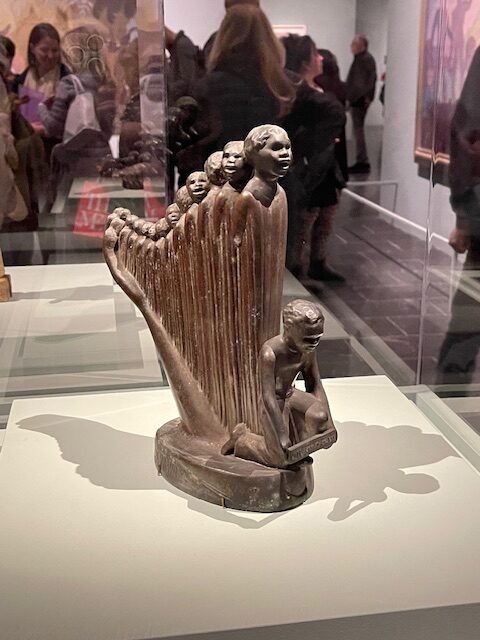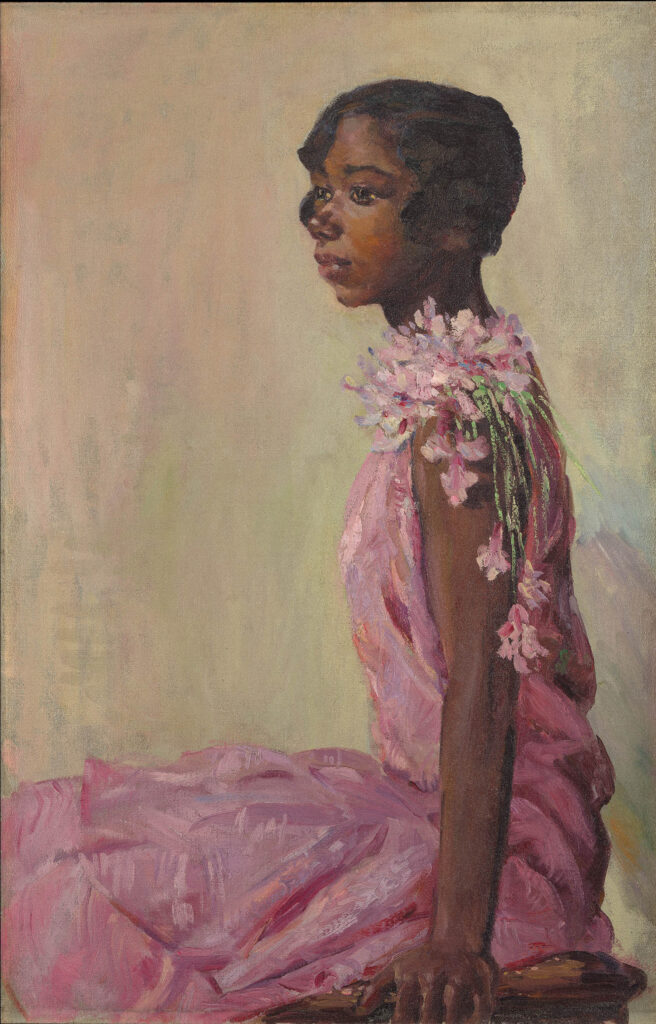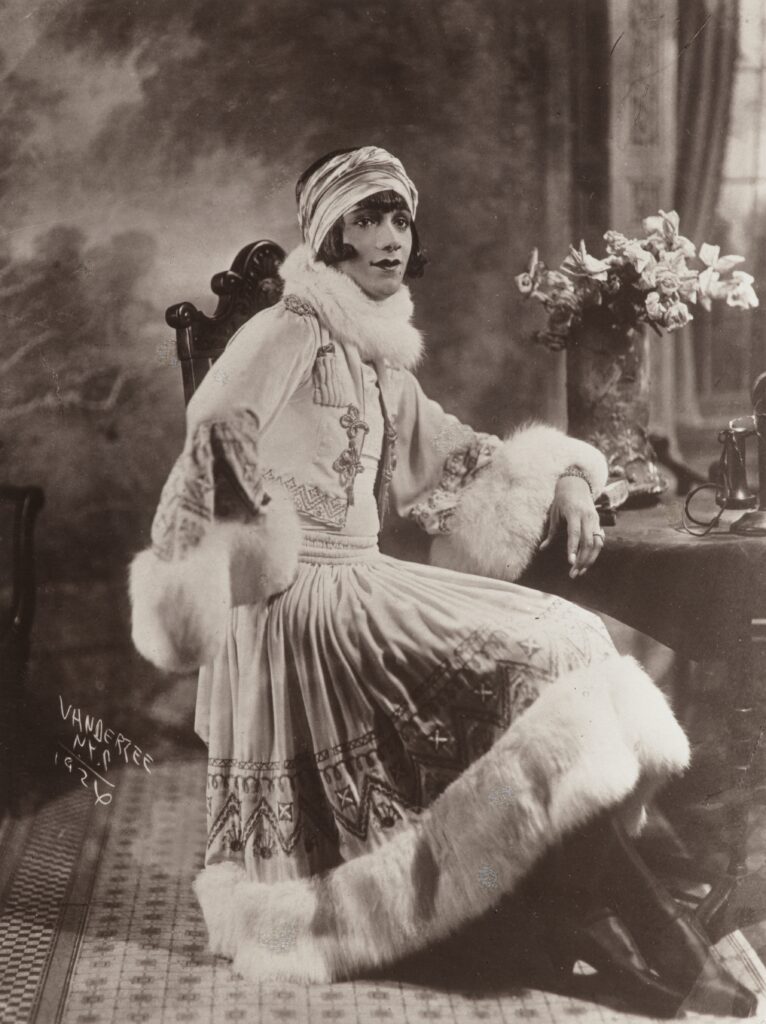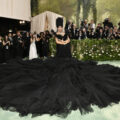
ABOVE PHOTO: A copy of Augusta Savage’s sculpture “The Harp”
By Constance Garcia-Barrio
Who could have foreseen the explosion of creativity that would take place after thousands of Black families — fleeing segregation, lynchings, and less farm work due to failed cotton crops in the South — moved north?
“The Harlem Renaissance and Transatlantic Modernism,” an exhibition in New York City’s Metropolitan Museum of Art, chronicles this cascading creativity with about 160 paintings, drawings, photographs, sculptures and videos. The movement began when World War I (1914-1918) fueled a robust job market that attracted rural Black folks to Chicago, Philadelphia, and other cities — especially Harlem.
Black visual artists, once shut out of schools, museums, and galleries, won praise portraying the lives of southern transplants in the Great Migration. In viewing Archibald Motley Jr.’s (1891-1981) vivid paintings one can almost smell the whiskey.
“I’ve always tried to paint my people just the way they were,” wrote Motley, a Chicago resident, in an essay.
Themes in the exhibition’s paintings range from billiards to the Biblical. One room spotlights muralist and graphic artist Aaron Douglas (1899-1979), who illustrated James Weldon Johnson’s (1871-1938) “God’s Trombones: Seven Negro Sermons in Verse,” a 1927 poetry collection. “The Creation,” done in cool oil colors, shows a huge open hand descended from the sky, as if God had just put on earth the small figure of man, newly animated with the breath of life.
“Noah’s Ark,” also by Douglas, is part of the exhibition. This scene in oil has many shades of blue while “Let My People Go,” an oil painting on wood based on the Book of Exodus, is filled with lavender and soft gold light.

Laura Wheeler Waring
(American, 1887-1948)
Girl in pink dress
ca. 1927
Oil on canvas; 36 ¼ x 26 ¼ x 2 ¼ in
Laura Wheeler Waring Family Collection
© Laura Wheeler Waring Image
© The Metropolitan Museum of Art, photo by Juan Trujillo
Douglas depicted many angular Black male figures, but Laura Wheeler Waring (1887-1948), created realistic portraits of African American women of different social strata. “Mother and Daughter,” (1927) shows the profiles of a brown-skinned mother and her fair-skinned daughter. In this painting, Wheeler Waring, who taught art at Cheyney Training School for Teachers (now Cheyney University), confronts the thorny topic of mixed-race families.
Wheeler Waring may have had a kindred spirit in photographer James Van Der Zee (1886-1983) who documented Harlemites of all kinds. Van Der Zee’s inclusiveness stirred the ire of famed sociologist and Pan-African activist W.E.B. Du Bois (1868-1963) at least once. Van Der Zee’s 1926 photo, “Beau of the Ball,” shows a drag queen in fur-trimmed garments. The man pictured may have participated in the annual Hamilton Lodge Balls, a cross-dressing gala held in Harlem in the 1920s and 1930s that drew thousands of spectators. Du Bois preferred to veil such aspects of Black culture, a guide said.

James Van Der Zee, (American, 1886–1983)
Person in Fur-Trimmed Ensemble
9 3/4 × 7 3/8 in. (24.8 × 18.8 cm)
James Van Der Zee Archive, The Metropolitan Museum of
Art; Gift of Donna Van Der Zee, 2021
2021.446.1.25 © James Van Der Zee Archive, The Metropolitan Museum of Art
Augusta Savage (1892-1962) began sculpting small figures as a child using clay found near her home in Green Cove Springs, Florida. Her father, a minister, who disapproved of her work “…almost whipped all the art out of me,” Savage once said.
After a move to New York in the early 1920s with $4.60 in her pocket, Savage became known for her portrait busts of such prominent people as W.E.B. Du Bois and Marcus Garvey (1887-1940), founder of the Universal Negro Improvement Association, a group which stressed Black pride and unity.
Commissioned to design a work representing the Black contribution to American music for the 1939 New York World’s Fair, Savage created “The Harp,” also known as “Lift Every Voice” — inspired by the song of the same name commonly referred to as the “Negro National Anthem — as a tribute to the song’s composer James Weldon Johnson. The 16-foot plaster sculpture looks like a gigantic hand and arm that support figures lined up like the strings of a harp.
When the World’s Fair ended, Savage couldn’t afford to have “The Harp” moved or stored, so it was destroyed. The exhibition has a model of “The Harp.”
Music boomed out of Harlem from the 1920s to the 1940s. Video clips of jazz singers like Cab Calloway (1907-1994), known for his acrobatic dancing and scat vocals — audible in one clip — added another dimension to the exhibition.
Other shorts feature stunning Josephine Baker (1906-1975), a standout in Broadway hit revues in 1920s. Later, her erotic dancing wowed audiences at the Folies Bergère, a Parisian music hall. Baker, who became a French citizen, was a spy for France during the German occupation in World War II.
The influence of the Harlem Renaissance crossed the Atlantic in both directions. German-born painter and graphic designer Winold Reiss (1886-1953), who arrived in the U.S. in 1913, won acclaim for “Two Public School Teachers.” The pale background of this pastel painting and the teachers’ gray dresses draw the viewer’s eye to their expressive brown faces. The painting probably represents Lucile Spence and Melva Price, who advocated for Black studies and school desegregation in the 1920s.
The galaxy of superstars in the exhibition includes poet, playwright, and activist Langston Hughes (1901-1967); anthropologist and author Zora Neale Hurston (1891-1960), writer, educator, and philosopher Alain Locke (1885-1954), and others.
With the crash of Wall Street in 1929, the end of prohibition in 1933, and the Harlem Race Riot of 1935, the Harlem Renaissance began to wane, but the momentum of its activism and self-expression endured.
In the 1930s, for example, Arturo A. Schomburg (1874-1938), a Puerto Rican of Black and German descent, “the unofficial librarian of the Harlem Renaissance,” had amassed thousands of documents that would form the foundation of what is now the Schomburg Center for Research in Black Culture, a branch of The New York Public Library, a world-renowned collection.
The Harlem Renaissance also sowed the seeds of the Civil Rights Movement. The exhibition includes Aaron Douglas’s pastel-on-paper portraits of Clarence Norris (1912-1989) and Haywood Patterson (1913-1952) two of the nine Scottsboro Boys, Black teenagers falsely accused of raping two white women on a freight train near Scottsboro, Alabama in 1931. The stark drawing, done around 1935, may have helped stoke continued awareness of their unjust imprisonment.
Josephine Baker made many trips to the U.S. in the 1950s and 1960s to support the Civil Rights Movement. She joined Martin Luther King Jr. in the 1963 March on Washington for Jobs and Freedom.
“The Harlem Renaissance and Transatlantic Modernism” represents a rare chance to see in one place some of the finest works that movement produced. One sips inspiration from every item displayed.
The exhibition will remain at the Metropolitan Museum, located at 1000 Fifth Avenue, New York City, until July 28, 2024. For more information, visit: https://www.metmuseum.org/exhibitions/the-harlem-renaissance-and-transatlantic-modernism
Consider an overnight stay if you see the exhibition. Book Amtrak well in advance for the best ticket prices. My companion and I paid $106 for roundtrip tickets from 30th Street Station for both of us. For a lower price, take SEPTA to Trenton and pick up New Jersey Transit to New York’s Penn Station. Ask for senior discounts, if applicable.
Many hotels in Manhattan’s theatre district are a short subway ride to the MET as well as a quick walk to shows but cost a bit more than lodging in other NYC neighborhoods. At The Hotel St. James, 109 W. 45th Street, a clean, quiet, no-frills room near Times Square was $243 with taxes. Wherever you stay, request a complimentary early check-in or late check-out to squeeze in a little more sightseeing.
















Leave a Comment